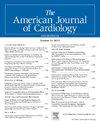Incidence of Elevated Cardiac Biomarkers in Patients Presenting to the Emergency Department With Allergic Symptoms: Implications for the Diagnosis of Kounis Syndrome
IF 2.1
3区 医学
Q2 CARDIAC & CARDIOVASCULAR SYSTEMS
引用次数: 0
Abstract
Noninfectious, allergic reactions affect many individuals and can range from mild to life-threatening. Kounis syndrome, an acute coronary syndrome triggered by allergic reactions, represents an association between allergies and myocardial ischemia. However, the significance of elevated cardiac biomarkers, particularly high-sensitivity cardiac troponin (hs-cTn), in patients presenting to the emergency department (ED) with allergic symptoms remains unclear. This study included consecutive patients who presented to the ED with symptoms of allergic reaction. All patients underwent serial electrocardiography and hs-cTnI testing. Patients with elevated hs-cTnI levels were further evaluated by dobutamine stress echocardiography. When acute coronary syndrome was suspected in an allergic context, coronary angiography was performed. Among the 200 patients studied, 52.5% were male, 5% had diabetes mellitus, and 24% had arterial hypertension. Urticaria was the most common manifestation, occurring in 73.5% of patients. Elevated hs-cTnI levels were detected in 12% of the patients, with 6% diagnosed with Kounis syndrome and the remaining 6% had myocardial injury without ischemia. Myocardial injury was more prevalent among patients with diabetes mellitus, arterial hypertension, dyslipidemia, and smoking history. Among the patients with Kounis syndrome, 8 had coronary disease, while only one with isolated myocardial injury had coronary artery disease. In conclusion, myocardial injury occurred in 12% of patients with allergic ED symptoms, with Kounis syndrome accounting for half of these cases. Elevated cardiac biomarkers during allergic reactions should prompt consideration of Kounis syndrome. Early recognition of this association is essential, particularly in patients with cardiovascular risk factors.
在急诊科出现过敏症状的患者中心脏生物标志物升高的发生率:对库尼斯综合征诊断的意义
背景:非传染性、过敏性反应影响许多个体,其范围从轻微到危及生命。Kounis综合征是一种由过敏反应引发的急性冠状动脉综合征,它与过敏和心肌缺血有关。然而,在急诊科(ED)出现过敏症状的患者中,升高的心脏生物标志物,特别是高敏感性心肌肌钙蛋白(hs-cTn)的意义尚不清楚。方法:本研究纳入了连续出现过敏反应症状的ED患者。所有患者均进行了连续心电图和hs-cTnI检测。通过多巴酚丁胺应激超声心动图进一步评估hs-cTnI水平升高的患者。当怀疑急性冠状动脉综合征在过敏背景下,冠状动脉造影进行。结果:200例患者中男性占52.5%,糖尿病占5%,高血压占24%。荨麻疹是最常见的表现,发生率为73.5%。12%的患者检测到hs-cTnI水平升高,其中6%诊断为Kounis综合征,其余6%为无缺血心肌损伤。心肌损伤在糖尿病、高血压、血脂异常和有吸烟史的患者中更为常见。在Kounis综合征患者中,有8例发生冠心病,而孤立性心肌损伤患者中只有1例发生冠心病。结论:过敏性ED患者心肌损伤发生率为12%,其中Kounis综合征占一半。过敏反应期间心脏生物标志物升高应提示考虑Kounis综合征。早期认识到这种关联是至关重要的,特别是在有心血管危险因素的患者中。
本文章由计算机程序翻译,如有差异,请以英文原文为准。
求助全文
约1分钟内获得全文
求助全文
来源期刊

American Journal of Cardiology
医学-心血管系统
CiteScore
4.00
自引率
3.60%
发文量
698
审稿时长
33 days
期刊介绍:
Published 24 times a year, The American Journal of Cardiology® is an independent journal designed for cardiovascular disease specialists and internists with a subspecialty in cardiology throughout the world. AJC is an independent, scientific, peer-reviewed journal of original articles that focus on the practical, clinical approach to the diagnosis and treatment of cardiovascular disease. AJC has one of the fastest acceptance to publication times in Cardiology. Features report on systemic hypertension, methodology, drugs, pacing, arrhythmia, preventive cardiology, congestive heart failure, valvular heart disease, congenital heart disease, and cardiomyopathy. Also included are editorials, readers'' comments, and symposia.
 求助内容:
求助内容: 应助结果提醒方式:
应助结果提醒方式:


